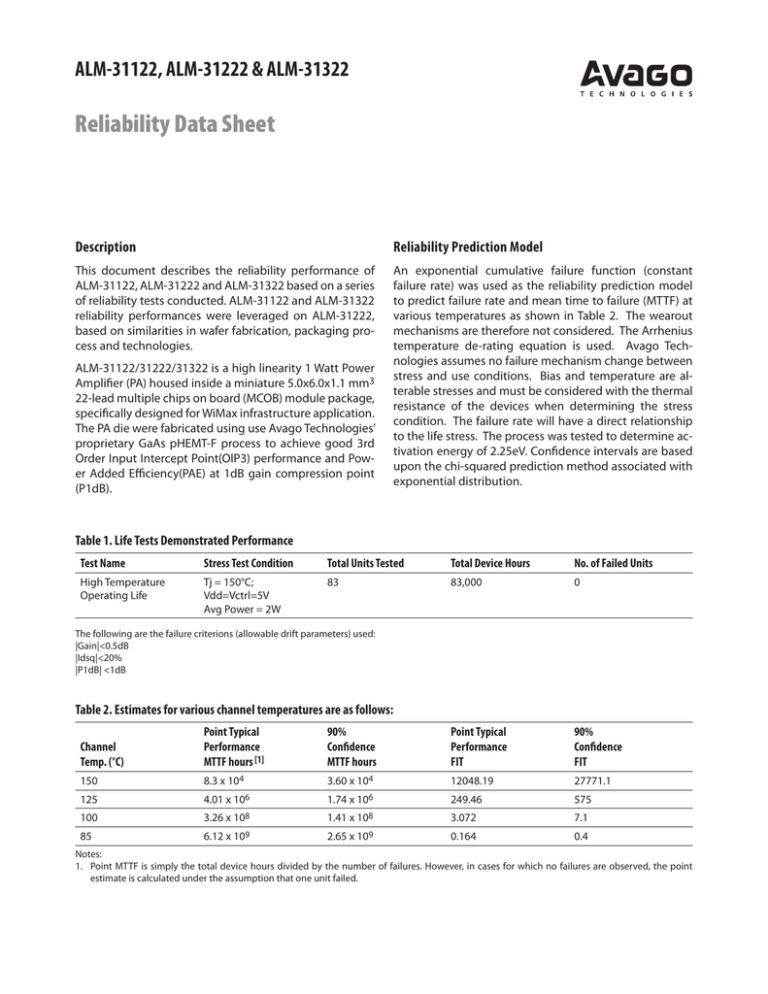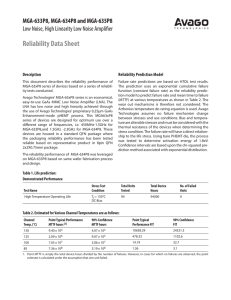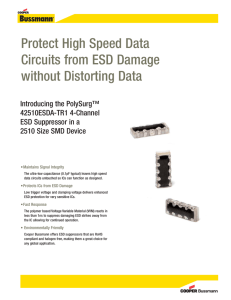
ALM-31122, ALM-31222 & ALM-31322
Reliability Data Sheet
Description
Reliability Prediction Model
This document describes the reliability performance of
ALM-31122, ALM-31222 and ALM-31322 based on a series
of reliability tests conducted. ALM-31122 and ALM-31322
reliability performances were leveraged on ALM-31222,
based on similarities in wafer fabrication, packaging process and technologies.
An exponential cumulative failure function (constant
failure rate) was used as the reliability prediction model
to predict failure rate and mean time to failure (MTTF) at
various temperatures as shown in Table 2. The wearout
mechanisms are therefore not considered. The Arrhenius
temperature de-rating equation is used. Avago Technologies assumes no failure mechanism change between
stress and use conditions. Bias and temperature are alterable stresses and must be considered with the thermal
resistance of the devices when determining the stress
condition. The failure rate will have a direct relationship
to the life stress. The process was tested to determine activation energy of 2.25eV. Confidence intervals are based
upon the chi-squared prediction method associated with
exponential distribution.
ALM-31122/31222/31322 is a high linearity 1 Watt Power
Amplifier (PA) housed inside a miniature 5.0x6.0x1.1 mm3
22-lead multiple chips on board (MCOB) module package,
specifically designed for WiMax infrastructure application.
The PA die were fabricated using use Avago Technologies’
proprietary GaAs pHEMT-F process to achieve good 3rd
Order Input Intercept Point(OIP3) performance and Power Added Efficiency(PAE) at 1dB gain compression point
(P1dB).
Table 1. Life Tests Demonstrated Performance
Test Name
Stress Test Condition
Total Units Tested
Total Device Hours
No. of Failed Units
High Temperature
Operating Life
Tj = 150°C;
Vdd=Vctrl=5V
Avg Power = 2W
83
83,000
0
The following are the failure criterions (allowable drift parameters) used:
|Gain|<0.5dB
|Idsq|<20%
|P1dB| <1dB
Table 2. Estimates for various channel temperatures are as follows:
Channel
Temp. (°C)
Point Typical
Performance
MTTF hours [1]
90%
Confidence
MTTF hours
Point Typical
Performance
FIT
90%
Confidence
FIT
150
8.3 x 104
3.60 x 104
12048.19
27771.1
125
4.01 x 106
1.74 x 106
249.46
575
100
3.26 x 108
1.41 x 108
3.072
7.1
85
6.12 x 109
2.65 x 109
0.164
0.4
Notes:
1. Point MTTF is simply the total device hours divided by the number of failures. However, in cases for which no failures are observed, the point
estimate is calculated under the assumption that one unit failed.
Table 3. Product Qualification – Operational Life Test Results
Stress
Conditions
Duration
Failures/number tested
High Temperature
Operating Life (HTOL)
Tj = 150°C, Vdd=Vctrl=5V
Average Power = 2W
1000 hours
0/83
Wet & High Temperature
Operating Life (WHTOL)
85°C/85% RH, Vdd=Vctrl=5V
1000 hours
0/81
Table 4. Product Qualification – Environment Stress Results
Stress
Conditions
Duration
Failures/number tested
High Temperature
Storage Life (HTSL)
125C
1000 hours
0/81
Wet High Temperature
Storage (WHTS)
85C/85%RH
1000 hours
0/80
Low Temperature
Storage Life (LTSL)
-40C
1000 hours
0/81
Temperature Cycle
(TMCL)
-55°C /125°C,
15mins dwell, 10mins transfer
1000 cycles
0/81
Liquid Thermal Shock
(LTMSK)
-65°C /150°C,
5mins dwell, 10secs transfer
1000 cycles
0/80
Solderability
8hrs Steam Aging,
Solder dipping at 245°C Pb free solder
1x
0/30
Table 5. Thermal Resistance Information
Stress
Product
Theta Jc
Thermal Resistance
ALM -31122
22°C/W
Thermal Resistance
ALM -31222
25°C/W
Thermal Resistance
ALM -31322
27°C/W
Electrostatic Discharge (ESD) Test Results
Table 6a. ALM-31122 ESD Results
ESD Test
Condition
Results
Human Body Model (HBM)
JESD22-A114-C
200V (Class 0)
Machine Model (MM)
JESD22-A115-A
80V(Class A)
ESD Test
Condition
Results
Human Body Model (HBM)
JESD22-A114-C
1000V (Class 1B)
Machine Model (MM)
JESD22-A115-A
200V(Class A)
ESD Test
Condition
Results
Human Body Model (HBM)
JESD22-A114-C
500V (Class 1A)
Machine Model (MM)
JESD22-A115-A
60V(Class A)
Table 6b. ALM-31222 ESD Results
Table 6c. ALM-31322 ESD Results
HBM
ESN Sensitivity
Class 0 is ESD voltage level < 240V, Class 1A is voltage
level between 250V and 500V, Class 1B is voltage level between 500V and 1000V, Class 1C is voltage level between
1000V and 2000V, Class 2 is voltage level between 2000V
and 4000V, Class 3A is voltage level between 4000V and
8000V, Class 3B is voltage level > 8000V.
The device is classified as ESD sensitive. The following precautions should to be taken:
MM
Class A is ESD voltage level <200V, Class B is voltage level
between 200V and 400V, Class C is voltage level > 400V.
1. Ensure Faraday cage or conductive shield bag is used
when the device is transported from one destination to
another.
2. At SMT assembly station, if the static charge is above
the device sensitivity level, place an ionizer near to the
device for charge neutralization purpose.
3. Personal grounding has to be worn at all time when
handling the device.
Moisture Sensitivity Level: Level 3
Preconditioning per JESD22-A113-D Level 3 was performed on all devices prior to reliability testing.
For product information and a complete list of distributors, please go to our web site:
www.avagotech.com
Avago, Avago Technologies, and the A logo are trademarks of Avago Technologies in the United States and other countries.
Data subject to change. Copyright © 2005-2008 Avago Technologies. All rights reserved.
AV02-1406EN - September 22, 2008





